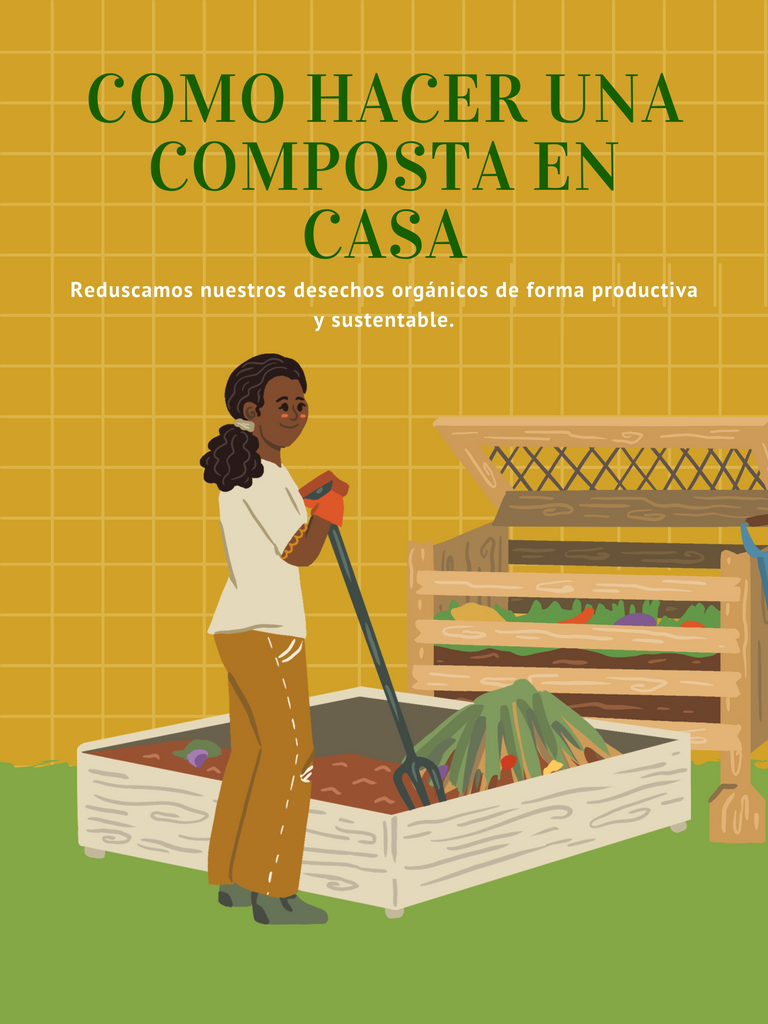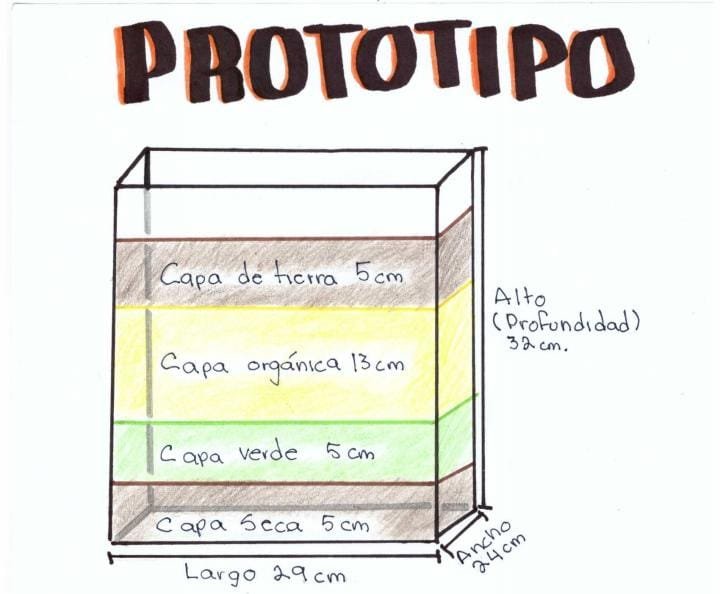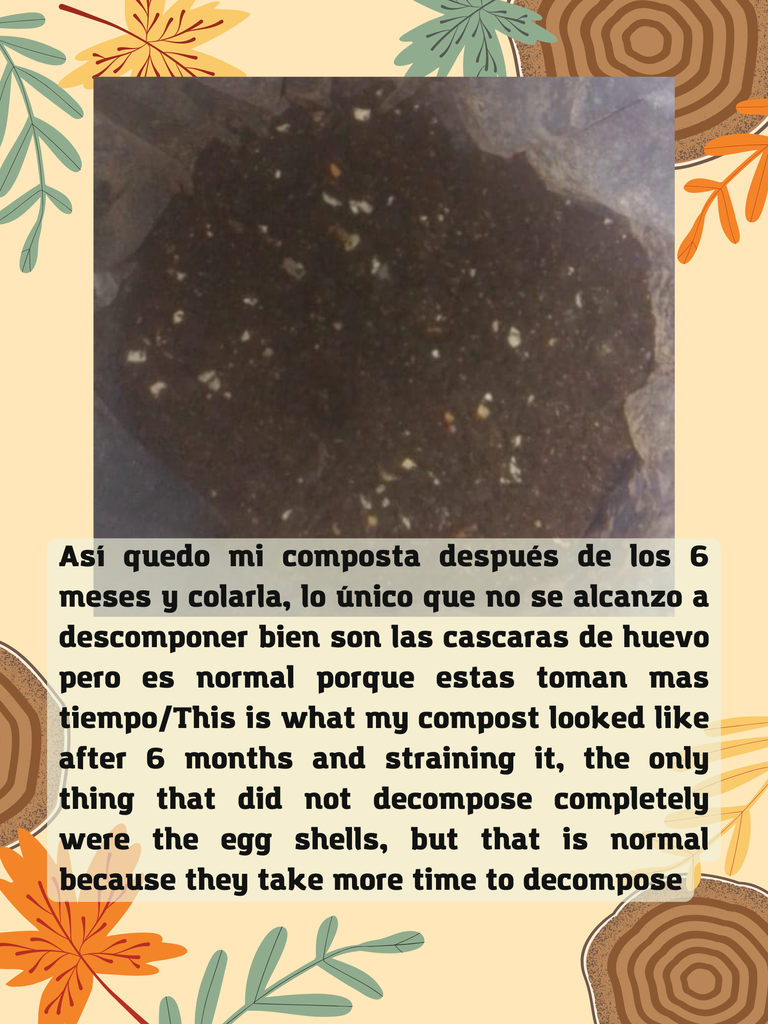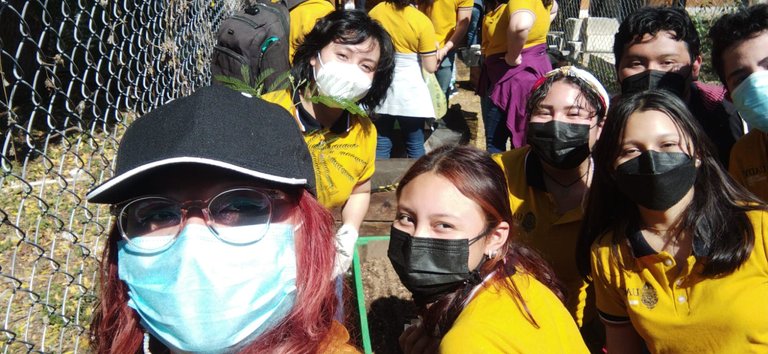Actualmente me encuentro cursando mi ultimo año de preparatoria y tomo clases de horticultura, este post esta inspirado en un proyecto que realicé en la escuela el cual me gusto mucho y les quiero compartir.
Hello everyone, after a long time I decided to publish again and this time I will talk about how to create a compost and the benefits it brings to our future planting, as well as the care we must take when making it, I hope you like it and find it useful.
I am currently in my last year of high school and I am taking horticulture classes, this post is inspired by a project I did in school which I really liked and I want to share with you.

Comenzaré explicando que es para mi la composta, la composta es una manera de aprovechar toda la basura orgánica que generamos día a día, descomponiéndose para después proporcionarle todos estos minerales y nutrientes a nuestros futuros cultivos.
Para hacer nuestra composta necesitamos:
Hojas secas, hojas verdes, toda la materia orgánica que podamos conseguir (cáscara de fruta, verduras, servilletas pero sin tinta, residuos de café de la cafetera pero no en exceso, cáscara de huevo), tierra sin abonar, una bolsa negra y un recipiente para armar la composta.
I will begin by explaining what composting is for me, composting is a way to take advantage of all the organic waste that we generate every day, decomposing it to then provide all these minerals and nutrients to our future crops.
To make our compost we need:
dry leaves, green leaves, all the organic matter we can get (fruit peels, vegetables, napkins but without ink, coffee residues from the coffee pot but not in excess, eggshells), unfertilized soil, a black bag and a container to assemble the compost.

Para empezar a hacer la composta necesitamos hacerle unos orificios al recipiente y a la bolsa negra para que pueda filtrar el agua y no se estanque. Comenzaremos poniendo una capa de aproximadamente 5cm de hojas secas, humedecemos esa capa con agua, después ponemos una capa hojas verdes y volvemos a humedecer, agregamos toda la materia orgánica que juntamos y humedecemos, ponemos una ultima capa que va a ser de tierra, humedecemos, cerramos la bolsa y lo dejamos así durante dos días. Pasados estos dos días tenemos que humedecerla un día si y el otro no y se revuelve igual.
La capa de materia seca aporta un buen drenaje y retiene humedad suficiente pero no en exceso, la capa de materia verde más que nada aporta el macro nutriente de nitrógeno a la tierra, y la materia orgánica brinda el mayor aporte de macro nutrientes ya que nos aporta nitrógeno, fósforo(que sirve para fomentar el crecimiento de las raíces, la floración y maduración), potasio(fortalece en general toda la planta, hace que crezcan las raíces, crea resistencia contra enfermedades), calcio, magnesio y azufre (que sirve para subir el pH del suelo y bajar la acidez).
To start making the compost we need to make some holes in the container and the black bag so that the water can filter and not stagnate. We will begin by putting a layer of approximately 5cm of dry leaves, we moisten that layer with water, then we put a layer of green leaves and we moisten again, we add all the organic matter that we gathered and we moisten, we put a last layer that will be of earth, we moisten, we close the bag and we leave it like that for two days. After these two days we have to moisten it every other day and stir it the same way.
The layer of dry matter provides good drainage and retains sufficient moisture but not in excess, the layer of green matter more than anything else provides the macro nutrient nitrogen to the soil, and organic matter provides the greatest contribution of macro nutrients as it provides nitrogen, phosphorus (which serves to promote root growth, flowering and ripening), potassium (strengthens the whole plant in general, makes the roots grow, creates resistance against diseases), calcium, magnesium and sulfur (which serves to raise the pH of the soil and lower the acidity).

Después de unos 6 meses aproximadamente ya debería haberse descompuesto por completo (si se quiere acelerar el tiempo de descomposición le podemos agregar lombrices y ahora seria un humus de lombriz, tiene la misma función que la composta y su única diferencia es que se descompone mas rápido) y ahora vamos a colar nuestra composta con una malla y ya estaría lista para agregársela a nuestros cultivos.
After approximately 6 months it should have decomposed completely (if we want to accelerate the decomposition time we can add worms and now it would be a worm humus, it has the same function as the compost and its only difference is that it decomposes faster) and now we are going to strain our compost with a mesh and it would be ready to add it to our crops.

La materia orgánica que yo le puse a mi composta le aporta:
CÁSCARA DE MANZANA: vitamina e, fósforo y potasio
CÁSCARA DE HUEVO: aporta calcio
LECHUGA: fósforo, hierro, calcio, potasio, vitamina c
TOMATE: fósforo, potasio, magnesio, manganeso vitaminas (A, B1, B3, B6, C, E, K)
CÁSCARA DE PLÁTANO: potasio
RESTOS DE PEPINO: fósforo
RESIDUOS DE CAFÉ: nitrógeno, fósforo y potasio
CÁSCARA DE PAPA: nitrógeno, potasio, hierro, calcio, vitaminas (C, B2)
CÁSCARA DE MELÓN: fósforo
CÁSCARA DE PIÑA: zinc, manganeso, vitaminas (A, B, C)
CÁSCARA DE NARANJA: vitamina c
CÁSCARA DE AGUACATE: hierro, magnesio, potasio
CÁSCARA DE MANDARINA: vitamina c
CÁSCARA DE SANDÍA: potasio, zinc, vitaminas (A, C, B6)
RESTOS DE CHAYOTE: sodio y potasio, vitaminas (c, folato, tiamina, Riboflamina, piridoxina)
RESTOS DE ZANAHORIA: carbono, nitrógeno, magnesio, manganeso y zinc
RESTOS DE CALABAZA: hierro, calcio, fósforo, potasio, magnesio, vitaminas (A, C, B1, B2, B3, B9)
RESTOS DE CEBOLLA: hierro, calcio, magnesio
RESTOS DE CHILE DULCE: calcio, hierro, fósforo, potasio, zinc, manganeso, vitaminas (C, E, K)
Lo que les recomiendo si lo van a hacer es que no dejen la composta afuera con el sol directo pero tampoco en un lugar cerrado porque es posible que suelte olores por la descomposición, se tiene que humedecer y revolver durante los 6 meses intercalando los días, unos días antes de colar la composta dejamos de humedecer, tanto a la capa verde como la de materia orgánica no hay que ponerle muchos cítricos porque eso puede hacer acida nuestra composta y no apta par todas las plantas, si la composta queda muy húmeda pueden triturar un poco de carbón, mezclarlo y dejamos de humedecer.
Espero les haya gustado mi regreso a hive con este post y les sea útil si quieren empezar a producir su propio abono, me despido dejándoles una foto de mi grupo en el huerto escolar y les deseo mucho éxito en lo que queda de esta semana, saludos.
The organic matter that I put in my compost provides:
APPLE SHELL: vitamin e, phosphorus and potassium.
EGG SHELL: provides calcium
LETTUCE: phosphorus, iron, calcium, potassium, vitamin c
TOMATO: phosphorus, potassium, magnesium, manganese vitamins (A, B1, B3, B6, C, E, K)
BANANA SHELL: potassium
Cucumber RESIDUE: phosphorus
COFFEE WASTE: nitrogen, phosphorus, potassium
POTATO SKINS: nitrogen, potassium, iron, calcium, vitamins (C, B2)
MELON SHELL: phosphorous
PINEAPPLE SKIN: zinc, manganese, vitamins (A, B, C)
ORANGE SHELL: vitamin c
AVOCADO SHELL: iron, magnesium, potassium
TANGERINE SHELL: vitamin c
SANDY PEEL: potassium, zinc, vitamins (A, C, B6)
CHAYOTE REMAINS: sodium and potassium, vitamins (c, folate, thiamine, Riboflamine, pyridoxine)
CARROT REMAINS: carbon, nitrogen, magnesium, manganese and zinc.
SQUASH REMAINS: iron, calcium, phosphorus, potassium, magnesium, vitamins (A, C, B1, B2, B3, B9)
ONION REMAINS: iron, calcium, magnesium, vitamins (A, C, B1, B2, B3, B9).
SWEET CHILI REMAINS: calcium, iron, phosphorus, potassium, zinc, manganese, vitamins (C, E, K).
What I recommend if you are going to do it is that you do not leave the compost outside in direct sunlight but not in a closed place because it is possible that it releases odors due to decomposition, it has to be moistened and stirred during the 6 months intercalating the days, a few days before straining the compost we stop moistening, Both the green layer and the organic matter layer should not have too much citrus because that can make our compost acidic and not suitable for all plants, if the compost is too wet you can grind some charcoal, mix it and stop moistening.
I hope you liked my return to hive with this post and that it will be useful if you want to start producing your own compost, I say goodbye leaving you a picture of my group in the school garden and I wish you much success in the rest of this week, greetings.

Foto de portada hecha en canva/Cover photo made in canva
El dibujo del prototipo es hecho por mi a mano/The prototype drawing is handmade by me.
Translated with the help of DeepL
https://www.deepl.com/es/translator
The rewards earned on this comment will go directly to the person sharing the post on Twitter as long as they are registered with @poshtoken. Sign up at https://hiveposh.com.
Your content has been voted as a part of Encouragement program. Keep up the good work!
Use Ecency daily to boost your growth on platform!
Support Ecency
Vote for new Proposal
Delegate HP and earn more